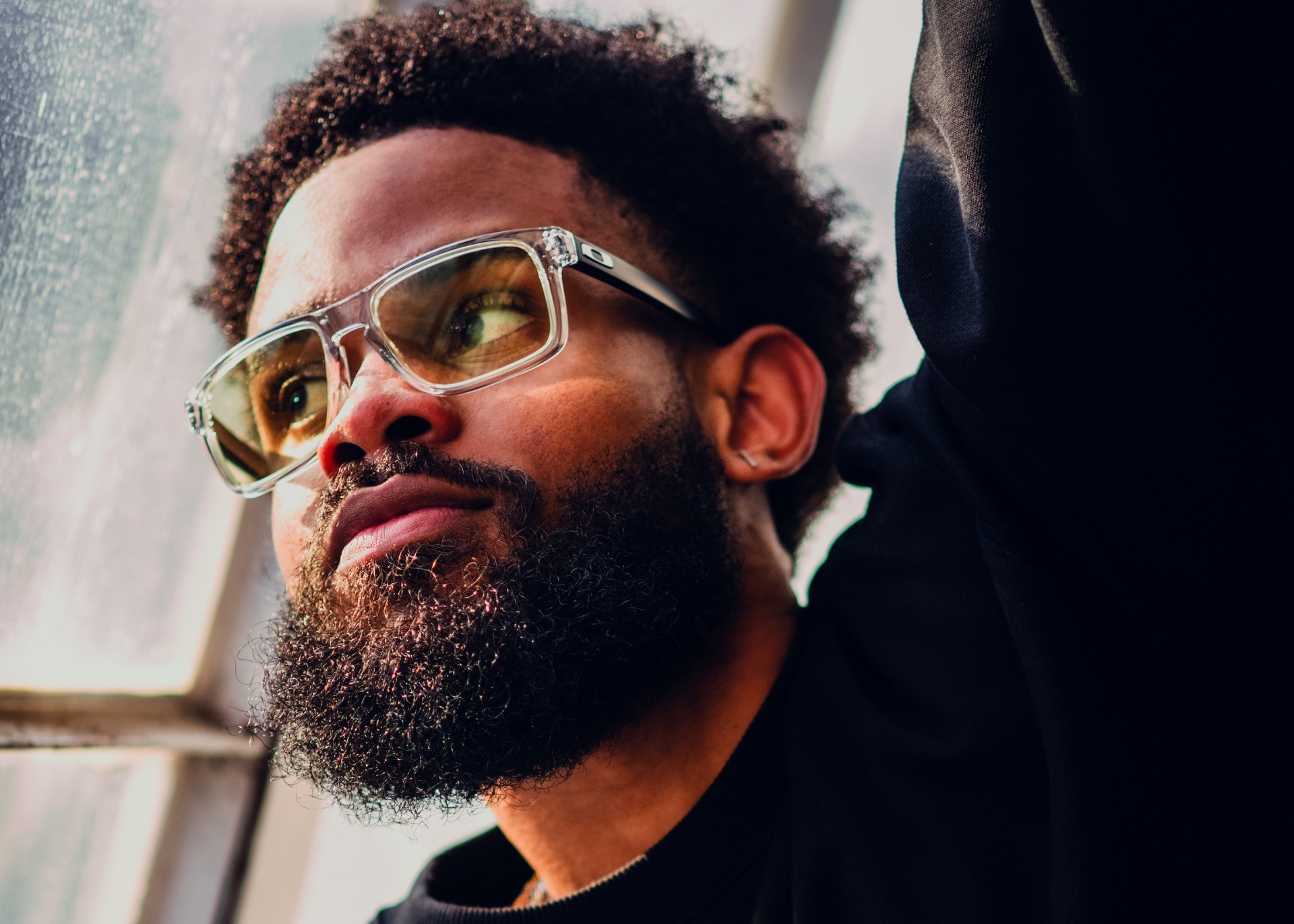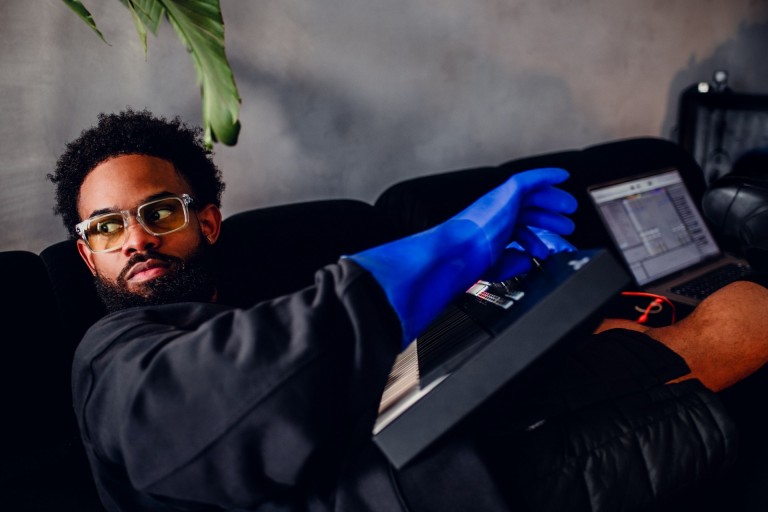All eyes are on French multidisciplinary designer and electronic music artist IGOR360 after he dropped the self-released EP “Pivot” last month. Born Igor Elie-Pierre who works under the alias of IGOR360 – he is an artist who defies categorization, seamlessly blending fine arts, design, fashion, and performance.
The EP’s lead single, ‘Merged Subjects,’ is a masterclass in experimentalism, accompanied by a mesmerizing dance film featuring New York-based dancers Emma Gordon and Madison Lynch. This collaboration is part of a broader research project exploring kinesthetic empathy, delving into how performers connect with their unseen digital audience through intuition and intersubjectivity.
IGOR360’s journey frequently takes him between the buzzing cities of Paris and New York, where his work in fashion photography has graced the essence of fashion weeks. His fascination with dance and movement is evident in “Merged Subjects,” where Emma’s expertise in stretch therapy and Madison’s dedication to suicide prevention advocacy bring profound depth to the project.
Beyond the visual and performance art, IGOR360’s EP features a stellar lineup of collaborators, including Parisian jazz pianist Hanxin Chi, Lagos-based violinist John Jesuyemi, and Lisbon’s soulful singer Ola Ruth. Together, they explore themes of acceptance, community, and identity, pushing the boundaries of what it means to be an artist in the digital age.
In his own words, IGOR360 sees his music as a dancer moving through various spaces, a vivid visualisation of emotionality and storytelling. Through the EP “Pivot,” he invites us to question: Can we communicate empathy across digital platforms? With IGOR360 at the helm, the answer is a resounding yes. Dive into the below interview to uncover the brainpower behind this avant-garde creation.

You’re a multidisciplinary designer and electronic music artist, and you have just released the EP, “Pivot”. How did it feel when you were on the brink of releasing this new project?
I’d say it was a very pivotal moment..haha! I think release is the word. I feel free and release myself. Happy, because I can finally share this with the universe, and also because I can redirect my focus onto another project. I often work on various projects at the same time but never actually finish any of them. It’s even harder for me to get things done when there are other people, and collaborators involved in the process. But this time, I was patient enough to accomplish everything the right way, going through the never-ending back and forths with the different parties involved, changes in collaborators, performing changes, and improvements in the writing. For the dance film, I went through even more overwhelming moments. I initially thought the whole project was going to take me about four months, but it ended up taking me over a year to finalise everything.
Will you walk me through your upbringing and how that has shaped your creativity?
I grew up in a very multicultural household. Music, fashion, dance, and art have always been part of my life. There was always jazz playing somewhere in the house, but I think, back then, I only liked the ones that had cool CD packaging designs. I’ve also been through times when I wanted to hear different things, different from the R&B, rap, and Latin music my friends were listening to. I always found it cool to stand out from the crowd and express some type of individuality. So, I’d go and dive into alternative rock. I was completely underdeveloped musically then, but I remember talking about forming a band with a childhood guitarist friend. That never actually happened; but in my mind, I was already a rock star.
I was mostly mesmerised by the bands’ grunge aesthetics, their rebellious energy, and the many different emotions they could evoke in just one live performance—almost like mixing hardcore Steve Aoki with the most calming Kygo sounds. Surprisingly, I’d find similar sets of emotions, maybe a little more polished, in the tons of high fashion, beauty, and portrait photography magazines where I used to browse for references to make drawings. Dynamic changes, duality, and contrast highlight the richness of human expression and intensely feed my creativity.
My formal training in design is something I value a lot. It has had a huge influence on the way I think as a professional artist. I tend to save special consideration for the audience or consumer, and I try to understand how my work will impact them emotionally. The work I create can sometimes be very personal, but I always question how people will relate to it as part of the process. Then, there are the principles of design, which I apply everywhere, even when writing music. Although I break the rules sometimes.
Your ingenuity spans across multiple fields – from fine arts and design to fashion and performance arts. How do these different disciplines influence each other in your work?
Creating across disciplines feels the same for me. My process starts with finding inspiration from old art references that portray similar emotions. I like to go back to my mentors: fine artists, music artists, dancers, architects, and thinkers whose paths or ideas have left a mark on me and have kept inspiring me for the past 10 years. If I can name a few: Solange Knowles, Pharrell Williams, Yohji Yamamoto, Herbie Hancock, Emmanuel Lubezki, Alejandro González Iñárritu, Bruce Lee, Henri Matisse, Alicia Keys, Jean-Michel Jarre, Frida Khalo, Santiago Calatrava, Virgil Abloh, Calvin Harris, Simone Rocha, Emma Watson, Misty Copeland, Damien Jalet, Tony Morrisson, Erving Goffman, Martha Graham, Georgia O’Keeffe, Mary Wigman, Micaela Taylor, Yoon Ahn, Nicolas Ghesquiere and William Carlos Williams. Lots of very expressive people, and there are more. Then there’s also a part of the inspiration that comes from ‘muses’ which can be anything, anyone, fellow artists and passionate people, or nature.
This is just to say that the sources of inspiration for my ideas are always the same and my creations are often mixed descendants of these various sources.
Once fully inspired, I try to find the best medium to convey the artistic message I wish to express. I am a very visual person. I create a mood board for every major phase in my creative process in any discipline. So the ‘Merged Subjects’ film, for example, the mood board was super eclectic using images of past and present influential choreographers and reading articles about them and extracting quotes from their philosophy. I also had expressive fashion images, portraits, and rehearsal images from dancer companies I follow on social media. When it was time to do the colour grading I had to create another mood board with more fashion imagery and paintings from the 17th to the 21st centuries. All of these disciplines easily influence one another, because I create a relationship with them from the very beginning. I can easily use one of those mood boards to design a fashion collection.
Speaking of fashion, how does that creative world influence your music?
Fashion is a sort of fuel for my music. There is nothing more inspiring to me than being around people who express themselves unapologetically through their outfits and naturally feel confident. Nothing too complex, really. Often, the smallest detail that shows some kind of authenticity is the most inspiring element.
I can’t help but study the emotional signals they convey through their style. I like to analyse people’s behaviour and appearances and understand how they are feeling. If I can decode how happy, low, or nervous they are, I would want to curate the sounds in my head that either suit their positive mental state or alleviate the negative ones. I think a DJ is like a stylist, and a music producer is like a fashion, industrial, or interior designer. For me, it is all about communication, creative branding, creating atmospheres, and moods.
Let’s talk about the lead single, ‘Merged Subjects’. You collaborated with New York-based dancers Emma Gordon and Madison Lynch for an experimental dance film. Can you tell us more about this collaboration and the concept behind it?
Hanging around my sister’s dance studio as a child sparked my interest in dance. Hearing the steps and the shouts from the teachers from the lobby, attending the general rehearsal and the actual performance with the set design, costumes, hair, and makeup, and progressively understanding the choreographic or theatrical process has left a mark on me. However, it was only a few years ago that I decided to take performance more seriously in my multimedia art practice.
For ‘Merged Subjects’, the idea was to move for the most diverse audience. When, as a performer, you are performing in a specific region or at a specific venue, you have an idea of who the majority of the guests will be—their social status and cultural interests. There’s also a great chance they already share some affinity for your work because they travelled to come see you. But what if you are creating dance-for-camera work and you don’t know who the viewer is but you want to facilitate social proximity, forge an ethical connection with them, and show empathy for them despite their different expectations?
I was lucky to collaborate with two attentive and understanding individuals and have them create movements based on the concept. I worked with them one at a time to choreograph intuitive dances based on the individual layers of sounds in the music, which alone are super eclectic rhythmically. I thought that would help create something emotionally intense and diversified. In addition to Emma’s and Madison’s work, there is what I call the Choreography of Camera and the Choreographic Editing which I had to be mindful of to create a more cohesive piece. I edited the piece as I went, and it took over three months for them to meet each other for a final duo. That day, they had blindfolds on for the first take. Then they were able to dance together, cooperate, and merge into one another for the following takes.
As someone who works across different artistic mediums, what advice would you give to aspiring artists trying to navigate multiple disciplines?
I’d say stay consistent and be patient. Make sure you find your voice. Allow yourself to find inspiration in the most unrelated and unexpected places, but don’t try to replicate someone else’s exact path. You don’t have to take into account every piece of advice or criticism that comes your way. Also, feel free to disregard my advice if you think it does not apply to you because there is only one You.
Follow IGOR360 On Instagram
Photographer: Robert Whitman
Interview by Izabel Rose
